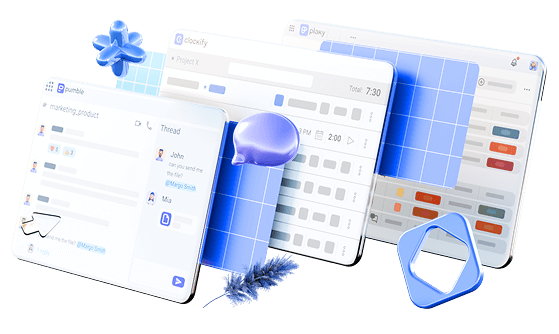We have all found ourselves feeling overwhelmed by thoughts and to-do lists, but when too many ideas fight for our attention, productivity goes out the window. Not to mention the debilitating stress that comes with excessive mental notes.
So do you really need to keep it all cluttered inside your mind?
Enter brain dump — a simple, no-rules method for clearing mental clutter and making sense of it all, equally effective for both managers and employees.
Let’s go over it in more detail and see how to make brain dump work for you.
- To brain dump means to write down everything that’s on your mind to clear mental clutter.
- Brain dumping helps reduce overthinking, anxiety, and stress.
- You can do it by freewriting, making lists, mind mapping, or using digital tools.
- Making brain dumps a habit can boost focus and productivity.
What is a brain dump?
Brain dumping means writing down everything in a notebook or app — tasks, worries, half-baked ideas. That way, you stop carrying it all in your head.
According to Merriam-Webster, a brain dump is “the act or an instance of comprehensively and uncritically expressing and recording one’s thoughts and ideas (as on a particular topic).”
Now, don’t confuse a brain dump with David Allen’s Getting Things Done mind sweep, which is a structured productivity technique. Brain dumping is way more relaxed, and the purpose is to release mental noise — not organize every little thing.
In other words, the goal isn’t to create the perfect to-do list but to free up space in your mind so you can focus, breathe, and get some rest without your brain running a marathon.
Interestingly, the brain dump technique is similar to journaling. The only difference is that brain dumping is time-restricted. For instance, CEO Andrey Fadeev explains that he dedicates 30 minutes to brain dumping at the end of each day or week to clear his mind of old information.
Conveniently enough, you can write in a notebook, type into an app, or even use a voice recorder — the method doesn’t matter. What matters is getting it all out.
Further reading:
If you’re looking for ways to become more mindful and improve productivity at the same time, take a look at our comprehensive guide:
How a brain dump helps you reset your mind
Brain dumping is backed by science. In fact, a Family Medicine and Community Health study found that journaling had a positive effect on mental health conditions like PTSD and anxiety.
Another study about journaling’s impact on mental health reported that 30% of participants felt calm or peaceful after their mind dump, while 24% noticed less stress and anxiety.
Likewise, a Forbes article states that regular brain dumps can help you:
- Reduce stress,
- Boost productivity, and
- Promote clarity.
When you start writing, you’re likely to notice the following benefits of brain dumping.
#1 Brain dumping stops overthinking in its tracks
When your brain is juggling a bunch of things at once, it’s easy to get stuck in analysis paralysis — thinking about what you need to do instead of actually doing it. A brain dump gets those thoughts out of your head and onto (digital) paper, so they stop overwhelming you.
#2 Brain dumping helps manage anxiety by untangling messy thoughts
Anxiety thrives on uncertainty and the feeling that there’s too much to handle. A brain dump places your worries outside your head, making them easier to process. Once you write things down, you can separate what needs action from what’s just mental noise. This is key for good management.
#3 Brain dumping creates space for focus and creativity
Your brain works best when it’s not cluttered with unfinished thoughts. A brain dump list frees up space for deep focus and creative problem-solving. When your mind isn’t busy trying to remember everything, you have more energy to get things done.
Bottom line? A brain dump isn’t some productivity hack — it’s self-care for your mind, whether you’re a top-ranking executive or a regular employee.
Further reading:
Disorganization affects you in many ways, but none of them is positive. Learn more about how and why this happens here:
Different brain dump methods to try
Not all brain dumps are created equal — what works for one person might feel like a mess for another. Similarly, as a manager, you might need a different approach compared to your team members.
The good news? There’s no right way to do it. It’s best to experiment and find a method that works for you.
Here are a few options to try.
Brain dump method #1: Freewriting — let it all spill out
This is the easiest, no-rules approach. Get a notebook, open a notes app, or even use a voice memo — then dump every thought as it comes. No editing, no overthinking, just a straight-up mind purge.
Best for: Clearing mental clutter fast, venting, or brainstorming new ideas.
Brain dump method #2: Categorized lists — organize the chaos
If you like a little structure, try sorting your brain dump list into categories — like work, personal, errands, random ideas, or things that keep you up at night. This helps you see what truly needs attention versus what’s just floating around, waiting to distract you.
Best for: People who want to dump and organize their thoughts at the same time.
Brain dump method #3: Visual brain dump — mind map your thoughts
Some people think in words, others in visuals — if you’re the latter, mind maps are your best friend. Start with a central topic (like ‘Work Stress’ or ‘Big Life Plans’), then branch out with related thoughts, ideas, or tasks. It’s great for connecting ideas and spotting patterns in your thinking.
Best for: Creative thinkers or anyone who processes information visually.
Brain dump method #4: Digital brain dump — let technology do the heavy lifting
If you live on your phone or laptop, as most team managers do, a digital brain dump might be the way to go.
With apps and online tools, you can quickly jot down thoughts, organize tasks, and track your to-dos without the risk of losing that random sticky note.
For instance, you can categorize your brain dump by setting up time blocks to tackle tasks. On the other hand, you can use premade templates to turn your mental clutter into a comprehensive plan.
Best for: Those who prefer to keep everything in one place and hate dealing with paper notes.
Further reading:
What’s a brain rot and how can you fight it to improve your work performance and overall productivity? Find your answers in this article:
How to make brain dumps a regular habit
To reap the benefits from any action, you need to make it a habit. The same goes for brain dumping. Here’s how to make brain dumps a regular part of your routine.
#1 Do a morning brain dump to set your day’s priorities
Instead of diving straight into work (or scrolling aimlessly on your phone), start your day with a quick brain dump. Get it all out, from your work to-dos to your personal worries. Then, highlight your top priorities so you know exactly where to focus.
Bonus tip: Pair this with your morning coffee — it’s like a caffeine boost for your brain’s organization skills.
#2 Use a brain dump technique before bed to avoid overthinking
Ever climbed into bed, only to suddenly remember everything you need to do tomorrow? Instead of tossing and turning, brain dump it all before you sleep. Writing things down signals to your brain that it doesn’t need to hold onto that information anymore, making it easier to relax.
Bonus tip: Keep a notebook by your bed for those random 2 a.m. thoughts.
Clinical psychologist Dr. Monica Vermani explains the process of brain dumping that she uses with her patients:

“I often assign patients with Generalized Anxiety Disorder (GAD) the task of creating a Worry Log, a brain dumping ‘diary,’ where they write down — by hand — all the thoughts that are ruminating and racing around in their head at the end of each day.”
In the expert opinion of Dr. Monica, the act of writing everything down promotes better sleep and a more peaceful mind:

“This process slows racing thoughts, calms the mind, and allows it to be at peace by seeing things in proper perspective, which is critical to supporting a good night’s sleep.”
#3 Schedule a weekly brain dump to review and plan ahead
Pick one day a week — Sunday, Friday, whenever — to do a big brain dump. This helps you clear out mental clutter, review your tasks, and plan for the upcoming week. Think of it like tidying up your brain so that the next week of managing your and your team’s work feels less chaotic.
Bonus tip: Use this time to sort your brain dump into categories — urgent tasks, future ideas, and things that don’t actually need your attention.
Brain dumping works best when it’s part of your routine, not just something you do when you’re overwhelmed. The more you use it, the more mental space you free up — so you can focus on what really matters (like achieving your goals and remembering where you left your keys).
Further reading:
If you fear you might have a case of procrastination, see our article on the matter and find the right solution:
Brain dump and clear your mind to stay focused and productive
When you get overloaded with to-dos, worries, and random ideas, it’s hard to focus on what truly matters. That’s where a brain dump comes in. It’s a simple yet powerful way to clear mental clutter, reduce stress, and regain control over your thoughts.
Whether you write in a notebook, type it out in an app, or map it visually, making brain-dumping a habit can help you stay sharp and productive.
And if you’re looking for tools to streamline your workflow and thought process even further, check out CAKE.com’s Productivity Suite — it’s packed with everything you need to stay organized and on top of your game.
How we reviewed this post: Our writers & editors monitor the posts and update them when new information becomes available, to keep them fresh and relevant.



